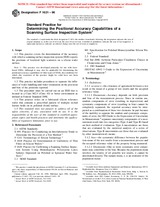We need your consent to use the individual data so that you can see information about your interests, among other things. Click "OK" to give your consent.
ASTM F1621-96
Standard Practice for Determining the Positional Accuracy Capabilities of a Scanning Surface Inspection System (Withdrawn 2003)
STANDARD published on 1.1.1996
The information about the standard:
Designation standards: ASTM F1621-96
Note: WITHDRAWN
Publication date standards: 1.1.1996
SKU: NS-50943
The number of pages: 8
Approximate weight : 24 g (0.05 lbs)
Country: American technical standard
Category: Technical standards ASTM
Annotation of standard text ASTM F1621-96 :
Keywords:
Localized light scattering, Particle analysis, Particle counting, Positional accuracy, Scanning surface inspection system (SSIS), SSIS (scanning surface inspection system), positional accuracy capabilities-scanning surface inspection system, (SSIS), practice,, Silicon semiconductors-slices/wafers, positional accuracy capabilities,emscanning surface inspection system, (SSIS), practice,,Order Form, ICS Number Code 29.045 (Semiconducting materials)
Additional information
| 1. Scope |
|
This standard was transferred to SEMI (www.semi.org) May 2003 1.1 This practice covers the determination of the accuracy with which a scanning surface inspection system (SSIS) reports the positions of localized light scatterers on a silicon wafer surface. Note 1-This practice was developed primarily for use with laser-based SSISs. Although it may also be applicable for determining the positional accuracy capabilities of other types of SSISs, the conditions for which this extension of the practice might be valid have not been determined.1.2 This practice includes procedures to separate the influences of wafer handling and wafer orientation on the precision and bias of the positions reported. 1.3 The procedure must be carried out on an SSIS that is located in a Class M2.5 (Class 10) or better environment as defined in Federal Standard 209E. 1.4 This practice relies on a fabricated silicon reference wafer that contains a prescribed pattern of multiple etched feature fields on its polished (front) surface. 1.5 This standard does not purport to address all of the safety concerns, if any, associated with its use. It is the responsibility of the user of this standard to establish appropriate safety and health practices and determine the applicability of regulatory limitations prior to use. |
We recommend:
Updating of laws
Do you want to be sure about the validity of used regulations?
We offer you a solution so that you could use valid and updated legislative regulations.
Would you like to get more information? Look at this page.




 Cookies
Cookies
